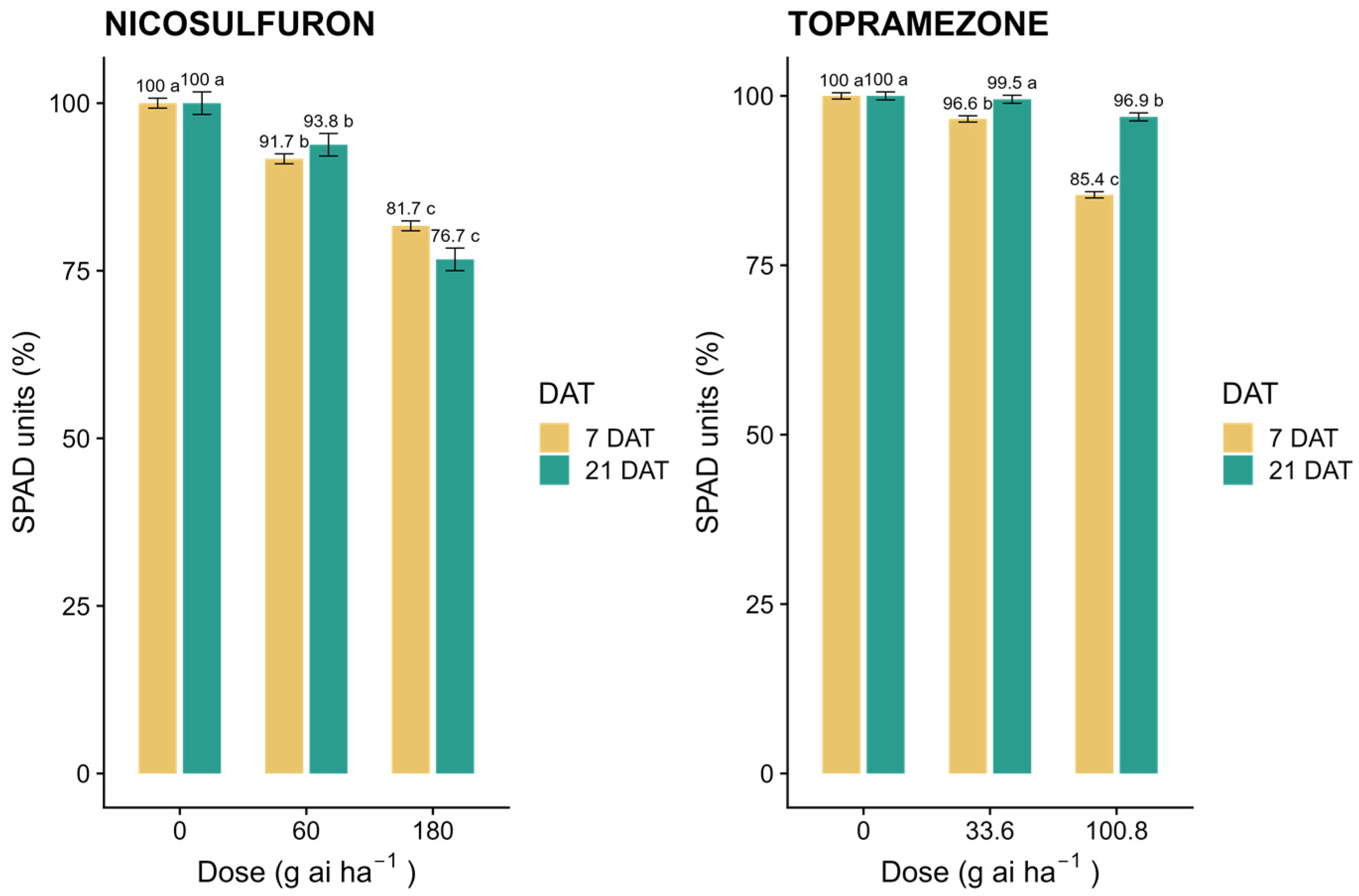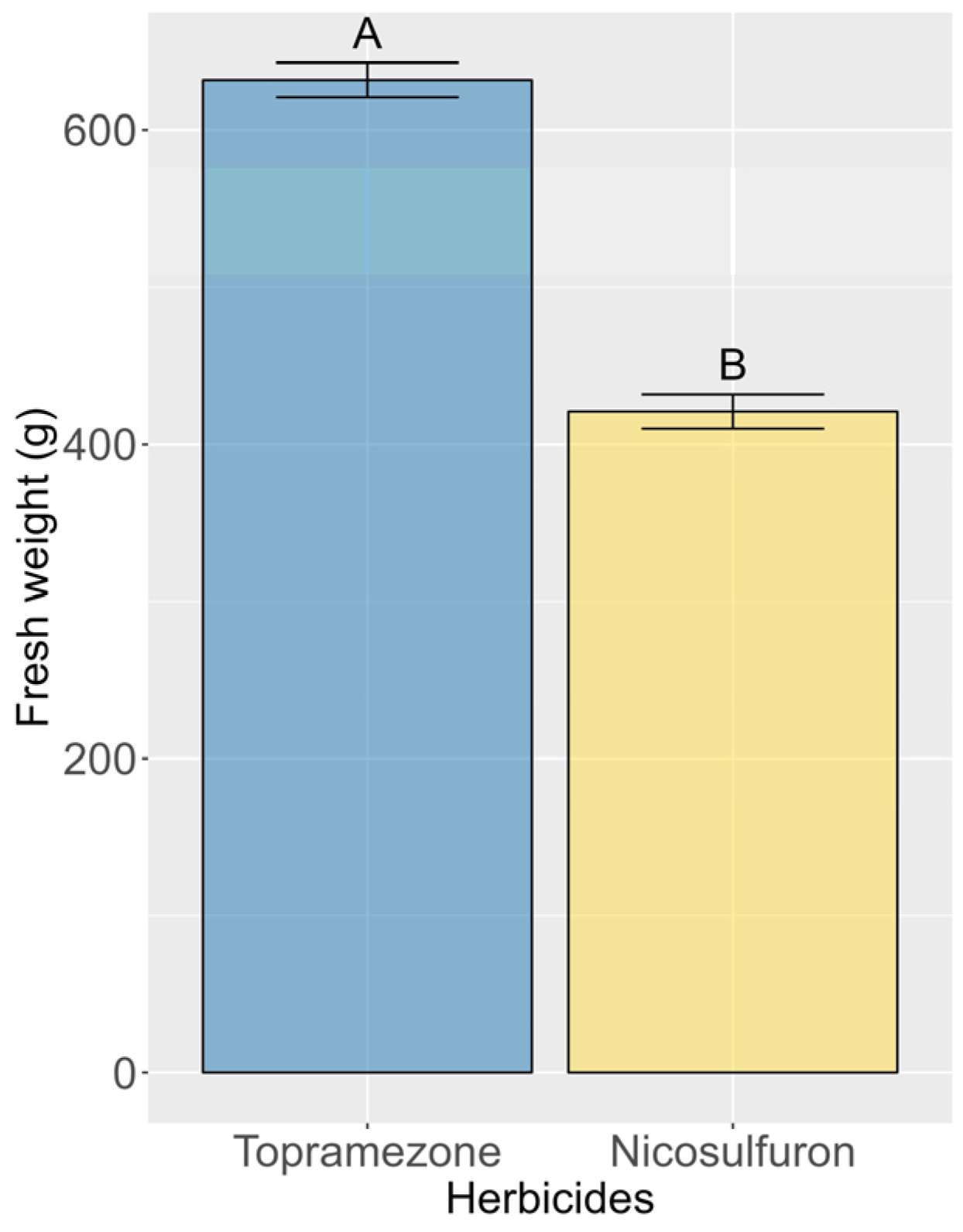Effect of ALS and 4-HPPD Inhibitor Herbicides on Maize Lines
Abstract
1. Introduction
2. Materials and Methods
2.1. Field Experiment
2.2. Application of the Treatments
2.3. Variables Evaluated
2.3.1. SPAD Index
2.3.2. Fresh Weight
2.3.3. Agronomic Variables
2.4. Statistical Analysis
3. Results
3.1. SPAD Index
3.2. Fresh Weight
3.3. Agronomic Variables
4. Discussion
5. Conclusions
Supplementary Materials
Author Contributions
Funding
Data Availability Statement
Acknowledgments
Conflicts of Interest
References
- Wang, J.; Hu, X. Research on corn production efficiency and influencing factors of typical farms: Based on data from 12 corn-producing countries from 2012 to 2019. PLoS ONE 2021, 16, e0254423. [Google Scholar] [CrossRef] [PubMed]
- Mhlanga, B.; Chauhan, B.S.; Thierfelder, C. Weed management in maize using crop competition: A review. Crop Prot. 2016, 88, 28–36. [Google Scholar] [CrossRef]
- Galon, L.; Bagnara, M.A.M.; Gabiatti, R.L.; Reichert, F., Jr.; Basso, F.J.M.; Nonemacher, F. Interference periods of weeds infesting maize crop. J. Agric. Sci. 2018, 10, 197–205. [Google Scholar] [CrossRef]
- Gharde, Y.; Singh, P.; Dubey, R.; Gupta, P. Assessment of yield and economic losses in agriculture due to weeds in India. Crop Prot. 2018, 107, 12–18. [Google Scholar] [CrossRef]
- Rehman, A.; Qamar, R.; Safdar, M.E.; MR Javeed, H.; Maqbool, R.; Farooq, N.; Shahzad, M.; Ali, M.; Tarar, Z.H. Critical competition period of Parthenium hysterophorus L. in spring maize (Zea mays L.). Plant. Daninha 2020, 38, e020214143. [Google Scholar]
- Imoloame, E.; Omolaiye, J. Impact of different periods of weed interference on Growth and Yield of Maize (Zea mays L.). J. Trop. Agric. 2016, 93, 245–257. [Google Scholar]
- Giraldeli, A.L.; Silva, G.S.d.; Silva, A.F.M.; Ghirardello, G.A.; Marco, L.R.d.; Victoria Filho, R. Efficacy and selectivity of alternative herbicides to glyphosate on maize. Rev. Ceres 2019, 66, 279–286. [Google Scholar] [CrossRef]
- Mahto, R.; Kumar, C.; Singh, R.K. Weed Management in maize (Zea mays L.) through 4-Hydroxyphenylpyruvate dioxygenase inhibitor herbicide with or without a methylated seed oil adjuvant. J. Pest. Res. 2020, 32, 179–185. [Google Scholar] [CrossRef]
- Wang, J.; Gao, H.; Guo, Z.; Meng, Y.; Yang, M.; Li, X.; Yang, Q. Adaptation responses in C4 photosynthesis of sweet maize (Zea mays L.) exposed to nicosulfuron. J. Ecotoxicol. Environ. Saf. 2021, 214, 112096. [Google Scholar] [CrossRef] [PubMed]
- Ndikuryayo, F.; Moosavi, B.; Yang, W.-C.; Yang, G.-F. 4-Hydroxyphenylpyruvate dioxygenase inhibitors: From chemical biology to agrochemicals. J. Agric. Food Chem. 2017, 65, 8523–8537. [Google Scholar] [CrossRef] [PubMed]
- Chen, P.; Xu, C.; Qiu, Y.; Wang, Y. A novel Zn2+-coordination fluorescence probe for sensing HPPD inhibitors and its application in environmental media and biological imaging. Ecotoxicol. Environ. Saf. 2024, 273, 116144. [Google Scholar] [CrossRef] [PubMed]
- Grossmann, K.; Ehrhardt, T. On the mechanism of action and selectivity of the corn herbicide topramezone: A new inhibitor of 4-hydroxyphenylpyruvate dioxygenase. Pest Manag. Sci. 2007, 63, 429–439. [Google Scholar] [CrossRef] [PubMed]
- Chakraborty, M.; Das, R.; Mondal, S.K. Study of acetolactate synthase and its mechanism of inhibition by sulfonylurea active ingredients: Amidosulfuron, nicosulfuron, cyclosulfuron–in-silico approach. Int. J. Chem. Environ. Sci. 2020, 1, 7–46. [Google Scholar] [CrossRef]
- Wang, L.; Riaz, M.; Song, B.; Song, X.; Huang, W.; Bai, X.; Zhao, X. Study on phytotoxicity evaluation and physiological properties of nicosulfuron on sugar beet (Beta vulgaris L.). Front. Plant Sci. 2022, 13, 998867. [Google Scholar] [CrossRef]
- Choe, E.; Williams, M.M. Expression and comparison of sweet corn CYP81A9s in relation to nicosulfuron sensitivity. Pest Manag. Sci. 2020, 76, 3012–3019. [Google Scholar] [CrossRef]
- De Oliveira, M.F.; Trindade, R.d.S.; de Oliveira, A.C.; Sallum, D.B.; Sallum, D.B. Tolerância diferencial de híbridos de milho ao herbicida nicosulfuron. Embrapa 2021, 1–14. Available online: https://www.infoteca.cnptia.embrapa.br/infoteca/handle/doc/1136317 (accessed on 14 November 2024).
- Ashburn Poppell, C.; Hayes, R.M.; Mueller, T.C. Dissipation of nicosulfuron and rimsulfuron in surface soil. J. Agric. Food Chem. 2002, 50, 4581–4585. [Google Scholar] [CrossRef]
- Regitano, J.B.; Koskinen, W.C. Characterization of nicosulfuron availability in aged soils. J. Agric. Food Chem. 2008, 56, 5801–5805. [Google Scholar] [CrossRef] [PubMed]
- Gitsopoulos, T.K.; Melidis, V.; Evgenidis, G. Response of maize (Zea mays L.) to post-emergence applications of topramezone. Crop Prot. 2010, 29, 1091–1093. [Google Scholar] [CrossRef]
- Spader, V.; Vidal, R.A. Seletividade e dose de injúria econômica de nicosulfuron aplicado em diferentes estádios de desenvolvimento da cultura do milho. Ciê. Rur. 2001, 31, 929–934. [Google Scholar] [CrossRef]
- Cavalieri, S.; Oliveira Junior, R.; Constantin, J.; Biffe, D.; Rios, F.; Franchini, L. Tolerância de híbridos de milho ao herbicida nicosulfuron. Planta Daninha 2008, 26, 203–214. [Google Scholar] [CrossRef]
- Tizhe, T.; Alonge, S.O.; Iortsuun, D.N.; Adekpe, D.I.; Batta, K. Evaluation of the effect of nicosulfuron at different times of application on the chemical component of maize (Zea mays). NUS Biosci. 2022, 14, 122–127. [Google Scholar] [CrossRef]
- Tizhe, T.D.; Alonge, S.O.; Adekpe, D.I.; Ioortsuun, D.N. Evaluation of the effect of nicosulfuron and bentazone herbicides on growth and yield performance of two maize varieties in Mubi, Nigeria. Asian J. Agric. 2023, 7, 122–130. [Google Scholar] [CrossRef]
- Novichonok, E.; Novichonok, A.; Kurbatova, J.; Markovskaya, E. Use of the atLEAF+ chlorophyll meter for a nondestructive estimate of chlorophyll content. Photosy 2016, 54, 130–137. [Google Scholar] [CrossRef]
- Team, R.C. RA Language and Environment for Statistical Computing; R Foundation for Statistical Computing, 2020. Available online: https://cir.nii.ac.jp/crid/1370298755636824325 (accessed on 14 November 2024).
- Charrad, M.; Ghazzali, N.; Boiteau, V.; Niknafs, A. NbClust: An R package for determining the relevant number of clusters in a data set. J. Stat. Softw. 2014, 61, 1–36. [Google Scholar] [CrossRef]
- Kassambara, A. Factoextra: Extract and Visualize the Results of Multivariate Data Analyses, R package version 1; 2016. Available online: https://cir.nii.ac.jp/crid/1370004235968325765 (accessed on 14 November 2024).
- Bónis, P.; Árendás, T.; Szőke, C.; Sugár, E.; Fodor, N.; Darkó, É.; Marton, L. Sensitivity of maize to herbicides in experiments in Martonvásár in 2015. Acta Agrar. Debr. 2015, 66, 47–52. [Google Scholar] [CrossRef]
- Brown, H.M. Mode of action, crop selectivity, and soil relations of the sulfonylurea herbicides. Pestic. Sci. 1990, 29, 263–281. [Google Scholar] [CrossRef]
- Carvalho, S.J.P.d.; Nicolai, M.; Ferreira, R.R.; Figueira, A.V.d.O.; Christoffoleti, P.J. Herbicide selectivity by differential metabolism: Considerations for reducing crop damages. Sci. Agric. 2009, 66, 136–142. [Google Scholar] [CrossRef]



| Doses | Nicosulfuron | Topramezone | ||||
|---|---|---|---|---|---|---|
| Control | 491.02 | SE (±)14.33 | a | 601.48 | (±)22.92 | ns |
| 1× | 442.29 | (±)14.33 | b | 654.05 | (±)22.92 | |
| 3× | 328.90 | (±)14.33 | c | 639.55 | (±)22.92 | |
| Variables | Doses g ai ha−1 | Nicosulfuron | Doses g ai ha−1 | Topramezone | ||||
|---|---|---|---|---|---|---|---|---|
| MF (days) | 0 | 73.93 | SE (±)0.76 | c | 0 | 71.76 | (±)0.35 | ns |
| 60 | 76.12 | (±)0.76 | b | 33.6 | 71.1 | (±)0.35 | ||
| 180 | 78.4 | (±)0.76 | a | 100.8 | 71 | (±)0.35 | ||
| FF (days) | 0 | 76.96 | (±)0.79 | c | 0 | 74.88 | (±)0.40 | ns |
| 60 | 79.09 | (±)0.79 | b | 33.6 | 73.83 | (±)0.40 | ||
| 180 | 81.81 | (±)0.79 | a | 100.8 | 73.88 | (±)0.40 | ||
| PH (cm) | 0 | 217.53 | (±)3.94 | a | 0 | 218.06 | (±)2.52 | a |
| 60 | 200.52 | (±)3.94 | b | 33.6 | 208.88 | (±)2.52 | b | |
| 180 | 198.89 | (±)3.93 | b | 100.8 | 193.24 | (±)2.52 | c | |
| EH (cm) | 0 | 129.1 | (±)4.09 | a | 0 | 125.74 | (±)1.90 | a |
| 60 | 119.24 | (±)4.10 | b | 33.6 | 123.84 | (±)1.90 | a | |
| 180 | 115.32 | (±)4.09 | b | 100.8 | 113.92 | (±)1.91 | b | |
| GW (g) | 0 | 50.9 | (±)1.53 | a | 0 | 51.05 | (±)1.44 | ns |
| 60 | 47.24 | (±)1.53 | b | 33.6 | 52.62 | (±)1.44 | ||
| 180 | 45.17 | (±)1.53 | b | 100.8 | 50.98 | (±)1.44 | ||
| Variables | Herbicides | Means | SE | Pr > F | |
|---|---|---|---|---|---|
| FF (days) | Topramezone | 74.20 | (±)0.50 | b | 0.0185 |
| Nicosulfuron | 79.29 | (±)0.50 | a | ||
| MF (days) | Topramezone | 71.29 | (±)0.50 | b | 0.0204 |
| Nicosulfuron | 76.15 | (±)0.50 | a | ||
| PH (cm) | Topramezone | 206.71 | (±)2.44 | ns | 0.7868 |
| Nicosulfuron | 205.64 | (±)2.44 | |||
| EH (cm) | Topramezone | 121.14 | (±)2.76 | ns | 0.9863 |
| Nicosulfuron | 121.22 | (±)2.76 | |||
| GW (g) | Topramezone | 51.55 | (±)1.24 | ns | 0.1643 |
| Nicosulfuron | 47.77 | (±)1.24 |
Disclaimer/Publisher’s Note: The statements, opinions and data contained in all publications are solely those of the individual author(s) and contributor(s) and not of MDPI and/or the editor(s). MDPI and/or the editor(s) disclaim responsibility for any injury to people or property resulting from any ideas, methods, instructions or products referred to in the content. |
© 2025 by the authors. Licensee MDPI, Basel, Switzerland. This article is an open access article distributed under the terms and conditions of the Creative Commons Attribution (CC BY) license (https://creativecommons.org/licenses/by/4.0/).
Share and Cite
Saavedra-Avila, J.I.; García Zavala, J.J.; Santacruz Varela, A.; Castillo González, F.; Crossa, J. Effect of ALS and 4-HPPD Inhibitor Herbicides on Maize Lines. Crops 2025, 5, 10. https://doi.org/10.3390/crops5020010
Saavedra-Avila JI, García Zavala JJ, Santacruz Varela A, Castillo González F, Crossa J. Effect of ALS and 4-HPPD Inhibitor Herbicides on Maize Lines. Crops. 2025; 5(2):10. https://doi.org/10.3390/crops5020010
Chicago/Turabian StyleSaavedra-Avila, José I., J. Jesús García Zavala, Amalio Santacruz Varela, Fernando Castillo González, and José Crossa. 2025. "Effect of ALS and 4-HPPD Inhibitor Herbicides on Maize Lines" Crops 5, no. 2: 10. https://doi.org/10.3390/crops5020010
APA StyleSaavedra-Avila, J. I., García Zavala, J. J., Santacruz Varela, A., Castillo González, F., & Crossa, J. (2025). Effect of ALS and 4-HPPD Inhibitor Herbicides on Maize Lines. Crops, 5(2), 10. https://doi.org/10.3390/crops5020010








